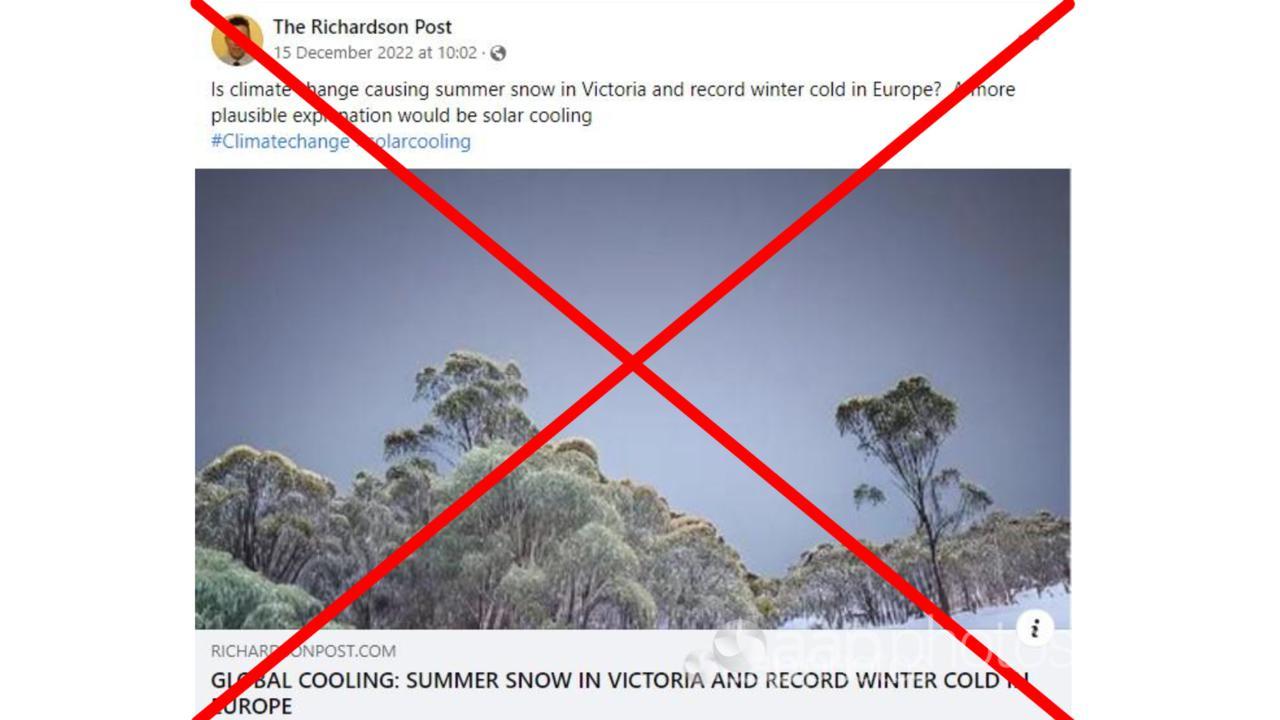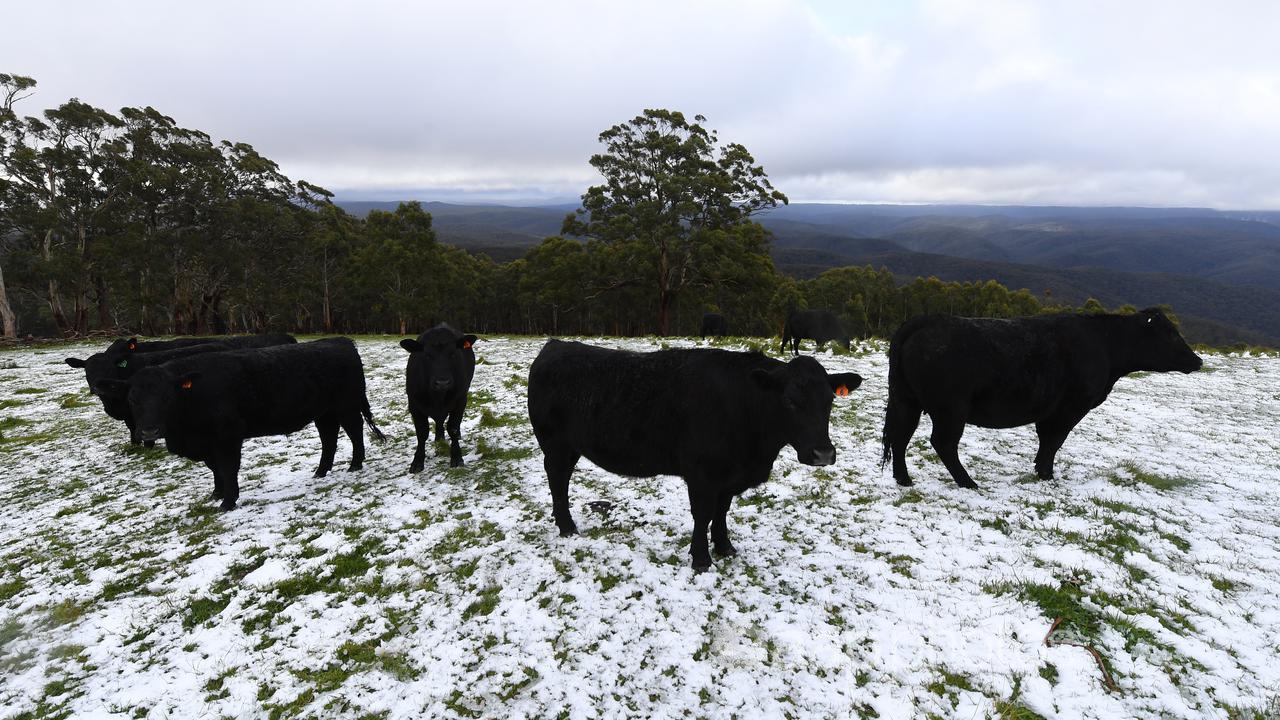An article shared on Facebook has used the unseasonably cold weather in Victoria before Christmas to promote a theory that solar cycles are solely responsible for climate change.
The claim is false. Experts told AAP FactCheck while the sun’s activity does fluctuate over time, changes in its energy output have a negligible effect on global warming.
They say climate change is being driven by man-made activity such a greenhouse gas emissions, a fact backed up by overwhelming scientific analysis.
The December 15 Facebook post (archived here) asks: “Is climate change causing summer snow in Victoria and record winter cold in Europe? A more plausible explanation would be solar cooling”.
It links to a blog article from December 13, which claims: “Carbon isn’t making the planet hotter. The sun is making it cooler.”

Citing the cold weather in Victoria, it claims “solar cooling” as part of the sun’s solar cycle “determines the rise and fall of civilisation”.
It continues: “The pattern repeats until we reach the Modern Solar Maximum of the 20th century. This ended around the year 2000, which is shortly before the globalists had to start fudging climate data to make it seem like the warming trend was continuing to the present. It’s not.”
Solar cycles happen about every 11 years, flipping the magnetic field. During certain points in the cycle, sunspot activity increases. The cycle’s peak is called the solar maximum.
However, while the sun’s activity does fluctuate, experts and scientific agencies say recent climate change is driven by human activity.
NASA says the cycles only change the sun’s energy output by up to 0.15 per cent.
Experts told AAP FactCheck the Facebook post and article are nonsensical, with no data backing up the claims.
“Solar cycles can impact the earth’s temperature but it’s tiny compared to the impact of greenhouse gases and scientists have modelled this,” Kim Reid, an atmospheric research fellow at Monash University, said in an email.
Observational astronomer Michael Brown, an associate professor at Monash University, said the “luminosity (the brightness) of the sun does vary a tiny bit, including semi-regular solar cycles that last for roughly 11 years”.
“However, the changes in the sun’s luminosity are insufficient to explain recent climate change,” Dr Brown told AAP FactCheck in an email.

The article linked to the Facebook post claims global warming ended with a solar maximum around the year 2000, which is incorrect. The overwhelming scientific consensus is earth is warming, not cooling.
The past eight years have been the warmest on record, according to the UN’s World Meteorological Association and research from NASA and the National Oceanic and Atmospheric Administration (NOAA).
The sun’s next solar maximum is predicted in 2025, while the previous one in 2014 was the weakest cycle in 100 years.
Andrew King, a climate scientist at the University of Melbourne, noted the climate impact from solar cycles was far outweighed by rises in greenhouse gases.
“Since the 19th century the effect of solar cycles has been swamped by the much greater influence of our greenhouse gas emissions,” Dr King told AAP FactCheck in an email.
“We know from our understanding of the climate system, our long-term observations of temperature from around the world, and experiments we can run with climate models, that solar cycles cannot explain the large-scale global warming we have seen over the last century.”
A study of “forcings“, or driving factors in climate change, by the Intergovernmental Panel on Climate Change (IPCC) found carbon dioxide increases by far outweighed solar irradiance (Page 136, Figure 2) between 1750 and 2005.
NASA’s Global Climate Change website reinforces that data, noting that “for more than 40 years, satellites have observed the sun’s energy output, which has gone up or down by less than 0.1 per cent during that period”.
It continues: “Since 1750, the warming driven by greenhouse gases coming from the human burning of fossil fuels is over 50 times greater than the slight extra warming coming from the sun itself over that same time interval.”

NASA scientists have repeatedly debunked claims solar cycle changes can somehow reverse global warming, with data showing solar irradiance largely unchanged over the past 150 years while temperatures have risen rapidly.
Dr Reid said the snow in Victoria before Christmas was part of a regular weather phenomenon.
“The reason we got snow in Victoria in December was because there’s a climate mode like El Niño in the Southern Ocean called the southern annular mode,” she said.
This can have dramatic effects on Australian weather, as explained in this video.
“Because of the phase of the southern annular mode, the high pressure system was slightly further south than it would normally be and so because of that we have cold air coming off the Southern Ocean to Victoria and that’s why we were able to get snow on the mountain,” Dr Reid said.

Despite the post stating Europe experienced record winter cold, including frigid temperatures on some dates, overall 2022 was the warmest year on record in Britain.
Dr Brown added: “The climate sceptic social media post … has technical jargon (polar vortex, Indian Ocean dipole) but has no hard numbers or analysis backing it up – it’s just words.”
The Verdict
The claim solar cycles are driving climate change is false. Experts told AAP FactCheck that solar activity during a solar cycle can cause some climate impact, but doesn’t account for the rapid warming since the start of the industrial revolution.
Solar cycles change the sun’s energy output by much less than one per cent and scientific data shows man-made emissions are overwhelmingly responsible for the rise in global temperatures.
False – The claim is inaccurate.
AAP FactCheck is an accredited member of the International Fact-Checking Network. To keep up with our latest fact checks, follow us on Facebook, Twitter and Instagram.
All information, text and images included on the AAP Websites is for personal use only and may not be re-written, copied, re-sold or re-distributed, framed, linked, shared onto social media or otherwise used whether for compensation of any kind or not, unless you have the prior written permission of AAP. For more information, please refer to our standard terms and conditions.


















